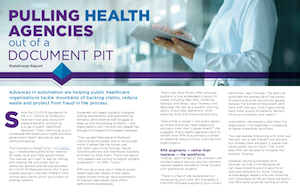- Sponsored
- Modernization
How healthcare agencies can tackle fraud, waste and abuse with RPA

State and local agencies are still feeling the strain of the COVID-19 pandemic on government health services — particularly as it pertains to processing claims.
Though the Coronavirus Aid, Relief, and Economic Security Act — or CARES Act — established a reserve for state, local and tribal governments to pay for testing and treatment of uninsured citizens, it also created payment channels different from normal daily claims. Errors with new coding requirements resulted in a mountain of backlog claims.

Read the full report.
That’s why many state health agencies turned their attention to robotic process automation (RPA) tools to help with the growing pile of documents.
RPA automatically flags improperly coded claims, verifies enrollment status and benefits, scans forms and submits claims to proper payment channels, according to a new report, produced by FedScoop and underwritten by Blue Prism, Bits In Glass and Red Hat.
Through rapid automation of manual rules-based, back-office administrative processes, RPA unburdens overwhelmed administrative staff in an already strained system. The new report dives deeper into the benefits of RPA technology.
Unprecedented demands during the crisis
When the pandemic hit last year, millions of Americans lost their jobs, prompting citizens to reach out for government assistance. That spike in Medicaid and Medicare claims caused a disruption in claims processing, especially for those states which still depend on legacy IT solutions and manual processes, according to Anna Twomey, senior solutions advisor and healthcare solutions architect for Blue Prism, in the report
She explained that with these delays, to the outside world, it looked like the money was not there, even though Congress had appropriated funds through the CARE Act to help.
Because the management of claims still uses manual processes, that creates a lot of backlog during spikes in demand, explained Josh Painter, RPA consultant with Bits In Glass, Blue Prism’s integration partner.
“These backlogs can be cleared when Blue Prism’s automation platform takes action on a document, and moves it into a system for verification, processing or reimbursement submission. It’s a simple way to make a big impact on the business,” he said in the report.
IT leaders across several states quickly sought out RPA as a cost-effective and secure solution to handle sensitive medical data, said Twomey in the report. Right now, Blue Prism’s RPA software platform is fully embedded in about 10 states, including New York, California, Georgia and Texas.
Long-term benefits for RPA implementation
The report looks at several of the benefits to using RPA, including reduce waste, protect from fraud and better streamline workflows. For example, Twomey says that automation helps to uncover loopholes in processes which previously created unseen waste.
“You see people interacting with what you thought was a well thought out process, but instead there are gaps in places that cause waste, loss or fraud. That is one area that RPA can be used to mitigate risk,” she said.
The report highlights other advantages of RPA over more traditional computerized workflows, including:
- Speed with which the organization can get to or disseminate information.
- The ability to capture information accurately in order to shed light on fraudulent activity or waste.
- Process high volumes of work.
To ensure RPA operates seamlessly within the system, Blue Prism, their integration partner Bits In Glass and Red Hat collaborated to produce a connected health solution which completes the data transformation for reliable and automated reimbursement. This further ensures interoperability of RPA, helps decrease submission errors and extends the reach of RPA workers.
The ability to automate the processing of thousands of claims and other documents greatly reduces the burden of redundant work from staff. It gets money back more quickly to patients, doctors, clinics and hospitals who need it.
Beyond claims processing, Twomey and Painter describe other use cases which they are helping their partners implement RPA. Those include cutting down on no-shows for appointments and using patient records for preventative care and predictive modeling of existing health issues.
Read more about the fully integrated, secure and automated claims processing solution to help patients and providers execute faster claims.
This article was produced by StateScoop and sponsored by Blue Prism, Bits In Glass and Red Hat.




